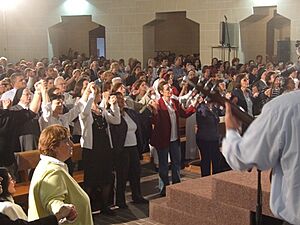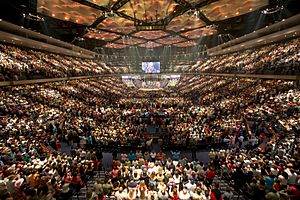Charismatic movement facts for kids
The charismatic movement is a special way of experiencing Christianity that has become popular in many churches around the world. It focuses on something called the baptism with the Holy Spirit and using spiritual gifts. These gifts are special abilities that Christians believe come from God, like healing or speaking in different languages.
This movement started around 1960 within the Anglican Church. From there, it quickly spread to other major Christian groups, including Lutherans and Presbyterians by 1962. It also reached Roman Catholics by 1967 and Methodists in the 1970s.
At first, the charismatic movement wasn't very strong in evangelical churches. But this changed in the 1980s with what was called the "Third Wave." Many new evangelical churches, like the Vineyard Movement, were formed because of it. However, some traditional evangelical churches still don't agree with the movement.
Contents
History of the Charismatic Movement
The charismatic movement is connected to Pentecostalism, which began in the early 1900s. Pentecostals believed in a powerful experience with God called the baptism with the Holy Spirit. Some thought that speaking in tongues (speaking in unknown languages) was a sign of this experience.
Before 1955, most mainstream churches didn't accept these Pentecostal ideas. If someone in a church openly shared these beliefs, they often had to leave their church.
However, the charismatic movement changed this. People who were influenced by Pentecostal ideas chose to stay in their own churches. This change became more popular after the Healing Revival from 1946 to 1958. During this time, leaders like William Branham and Oral Roberts held large meetings. They focused on the spiritual gifts, which helped more people learn about and accept these practices.
The charismatic movement officially began on April 3, 1960. On that day, Dennis J. Bennett, a priest at St. Mark's Episcopal Church in Van Nuys, California, told his church about his own Pentecostal experience. He shared it again on the next two Sundays, and many people in his church had similar experiences. Even though he had to resign, the news spread quickly.
The movement then grew to other major churches. Pastors began to have these experiences and share them publicly. They started holding special meetings for people seeking spiritual experiences and for healing. These meetings often included praying for people and anointing them with oil. The charismatic movement reached Lutheran and Presbyterian churches by 1962.
The Catholic Charismatic Renewal started in 1967 at Duquesne University in Pittsburgh, Pennsylvania. Methodists joined the movement in the 1970s.
The charismatic movement also led to the creation of many "covenant communities," like Sword of the Spirit. These communities bring together Christians from different churches, such as Catholics, Lutherans, and Methodists, to live and pray together. This helps them work towards ecumenism, which means unity among different Christian groups.
Even though Pentecostals and evangelicals have a lot in common, the charismatic movement didn't influence evangelical churches much at first. C. Peter Wagner noted that it started spreading within evangelicalism around 1985. He called this the Third Wave of the Holy Spirit. This "Third Wave" led to new churches and groups, often called "neo-charismatic." Examples include the Vineyard Movement.
Core Beliefs of Charismatic Christians
Charismatic Christians believe in an experience called baptism with the Holy Spirit. They also believe that spiritual gifts, which are special abilities from the Holy Spirit mentioned in the New Testament, are still available to Christians today. These gifts can come through the Holy Spirit "filling" or "baptizing" a person.
They believe that baptism in the Holy Spirit is a special act of God. It usually happens when someone is open and willing to receive a fresh outpouring of the Holy Spirit in their life. This experience helps to "unleash" the Holy Spirit that is already inside a person from their baptism. It also "equips and inspires" people for serving God and living out their faith. Many who have had this experience say it makes them feel closer to Jesus and gives them a new desire to read the Bible and live a holy life.
The Bible lists many gifts from God. However, the charismatic movement especially focuses on nine supernatural gifts mentioned in 1 Corinthians 12:8–10:
- Word of wisdom
- Word of knowledge
- Faith
- Gifts of healing
- Miraculous powers
- Prophecy (speaking messages from God)
- Distinguishing between spirits (knowing if a spirit is from God)
- Speaking in different tongues (languages)
- Interpretation of tongues
While Pentecostals and charismatics share these beliefs, they have some differences. Many charismatics wanted to be separate from Pentecostalism for cultural and theological reasons. One main difference is that many Pentecostals believe speaking in tongues is always the first sign of receiving Spirit baptism. Charismatics, however, generally believe the Holy Spirit is already present in a person from the time they become a Christian. They might call later experiences with the Holy Spirit "being filled" instead of "baptism." Unlike Pentecostals, charismatics accept many different supernatural experiences—like prophecy, miracles, or healing—as signs of being filled with the Holy Spirit.
Pentecostals and charismatics also differ in their style. Pentecostals have traditionally focused a lot on evangelization (sharing their faith) and missionary work. Charismatics, on the other hand, often see their movement as a way to bring new life and energy to their existing church traditions.
Some Christians, called Cessationists, believe that these special "sign" and "revelatory" gifts were only for a specific time in the early church and are no longer active today. However, the charismatic movement believes these gifts are still available and active today.
Christian Groups Influenced
Anglicanism
In the United States, Dennis Bennett, an Episcopalian priest, is often seen as a key figure in the charismatic movement. In 1960, he announced to his church in Van Nuys, California, that he had received the outpouring of the Holy Spirit. He later led workshops in Seattle about the work of the Holy Spirit.
In the United Kingdom, leaders like Colin Urquhart and Michael Harper were important in similar developments.
In New Zealand, the movement grew after a conference in 1964. Rev. Ray Muller invited Dennis Bennett to New Zealand in 1966, which helped spread the "Life in the Spirit" seminars.
Today, a "charismatic evangelical" group is recognized within the Church of England. London's Holy Trinity Brompton church has been very influential in this movement. Justin Welby, who became the Archbishop of Canterbury in 2013, has a background in charismatic evangelicalism.
Lutheranism
Larry Christenson, a Lutheran theologian in California, helped explain the charismatic movement to Lutherans in the 1960s and 1970s. Large annual conferences were held in Minneapolis during those years. Some Lutheran charismatics in the U.S. formed the Alliance of Renewal Churches.
Richard A. Jensen's book Touched by the Spirit (1974) was important for Lutherans to understand the movement. Another Lutheran charismatic leader is Morris Vaagenes. In Finland, the rise of charismatic churches has even helped increase attendance in some Lutheran congregations.
Reformed Churches
In Congregational and Presbyterian churches, which follow Calvinist or Reformed theology, there are different views on whether spiritual gifts still exist today. However, Reformed charismatics usually keep a distance from renewal movements that seem too emotional, like Word of Faith or the Toronto Blessing.
Important Reformed charismatic groups include the Sovereign Grace Churches and the Every Nation Churches in the United States. In Great Britain, the Newfrontiers churches, started by Terry Virgo, are also Reformed charismatic.
Roman Catholicism
In the United States, the Catholic Charismatic Renewal was led by people like Kevin Ranaghan at the University of Notre Dame. Duquesne University in Pittsburgh also began hosting charismatic revivals in 1977.
Cardinal Joseph Ratzinger (who later became Pope Benedict XVI) wrote in 1983 that a "new experience of the Holy Spirit suddenly burst forth" in the world. He said that what the New Testament says about spiritual gifts is "once again becoming extremely topical." He encouraged church leaders to welcome this renewal and for members to stay connected to the wider Church.
In the Roman Catholic church, the movement became very popular among Filipino, Korean, and Hispanic communities in the United States, as well as in the Philippines and Latin America, especially Brazil. Priests and lay people involved in the movement often visit churches and lead special "charismatic masses." It is thought to be the second-largest distinct group within global Catholicism, with about 120 million members.
Some charismatic Catholics use language about "Baptism in the Holy Spirit" that others in their church might find confusing, as it sounds similar to the sacrament of confirmation. However, for Catholics, "Baptism of the Spirit" is one spiritual experience among many. For example, Padre Pio described a powerful spiritual experience during his confirmation at age 12, where he felt God's "fullness and perfection." This could be seen as his "baptism by the Spirit."
The Compendium to the Catechism of the Catholic Church explains that "Charisms are special gifts of the Holy Spirit which are given to individuals for the good of others, the needs of the world, and in particular for the building up of the Church." Recent Popes, including Pope Francis, have encouraged Catholics to have a deeper relationship with the Holy Spirit. In 2019, Pope Francis encouraged everyone in Charismatic Renewal "to share baptism in the Holy Spirit with everyone in the Church."
Methodism
In the Methodist tradition, baptism with the Holy Spirit has traditionally referred to a "second work of grace" after becoming a Christian. This is called entire sanctification, where a person is made "perfect in love."
When Methodism began, many people reported supernatural healings, visions, and special wisdom. John Wesley, the founder of Methodism, believed that spiritual gifts were a natural result of true holiness. Because of this history, many Methodist churches now have charismatic worship, although some do not.
Some Methodist groups, like the Pilgrim Holiness Church, do not agree with the Pentecostal idea that speaking in tongues is always a sign of the Spirit's baptism. They emphasize that the goal is to be "perfect in love."
Charismatic Methodists in the United States are connected with the Good News caucus. In the United Methodist Church, a group called Aldersgate Renewal Ministries was formed to help renew the church through the Holy Spirit.
Moravianism
Some members of the Moravian Church have also accepted parts of the charismatic movement as it spread.
Adventism
A small number of Seventh-day Adventists today are charismatic. In the early years of the church, charismatic experiences were common.
Eastern Orthodoxy
The charismatic movement has not influenced the Eastern Orthodox Church as much as other Christian groups. While some Eastern Orthodox priests have encouraged charismatic practices, many within the church see the movement as not fitting with Orthodox beliefs. For example, one article stated that the charismatic movement is "incompatible with Orthodoxy."
Despite this, some priests do promote charismatic renewal in groups like the Antiochian Orthodox Christian Archdiocese.
Nondenominational Churches
The charismatic movement also led to the creation of many independent evangelical charismatic churches. These churches are often nondenominational, meaning they don't belong to a specific larger denomination. Calvary Chapel in Costa Mesa, California, founded in 1965, was one of the first. Victory Outreach International started in Los Angeles in 1967. In the United Kingdom, the Jesus Army, founded in 1969, is another example of this influence. Many other churches like these were started around the world.
Key Thinkers and Scholars
- Jack Deere (Presbyterian)
- Wayne Grudem (Reformed / Vineyard)
- Derek Prince (Non-denominational)
- Kevin Ranaghan (Roman Catholic)
See also
- Charismatic Christianity
- Glossolalia
- Pentecostalism



